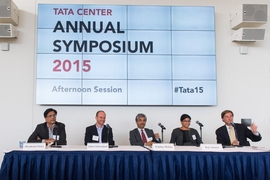The historic gardens of the Mughal Empire in India and Pakistan first drew James Wescoat to the Indus Basin four decades ago. A landscape architect and professor in the Aga Khan Program for Islamic Architecture in the MIT Department of Architecture, Wescoat has returned to the region many times for research that spans studies of 17th-century waterworks and 21st-century water systems, policy analyses, and multilateral water agreements.
With his interconnected webs of relationships and knowledge, Wescoat has assumed a pivotal role in the cross-disciplinary, multinational study of water in the Indus Basin.
Of a climate change study he led for the Pakistan Water and Power Development Authority and the U.S. Environmental Protection Agency, Wescoat says, “We were a team of archeologists, historians, hydrologists, and water engineers. We were able to think broadly and deeply about the Indus Basin as one of the world’s great laboratories of water management.”
Flowing down from the great Himalayan-Hindu Kush-Karakorum mountain ranges, the Indus River delivers glacial meltwater to the fertile plains of Pakistan and India, which depend on the river for food, energy, and water. But despite the abundance of their shared resource, these countries suffer chronic malnutrition, energy blackouts, and water shortages.
Wescoat’s ability to connect teams in an array of disciplines is encouraging synergies among researchers who envision a better future for the Indus Basin and its people through smart, sustainable water management practices, policies, and technologies.
His partners in Pakistan include the new Centre for Water Informatics and Technology (WIT) of the Lahore University of Management Sciences (LUMS). “WIT has devised innovative canal management and data transmission technologies that monitor water flows precisely and in real time,” says Wescoat, who chairs the WIT Advisory Group. “WIT’s pioneering systems can revolutionize water management.”
“Professor Wescoat has deep understanding of the historical and geographical importance of the Indus Basin,” says LUMS associate professor of electrical engineering Abubakr Muhammad, founding director of WIT. “His expertise has helped us to formulate our unique vision for WIT and to imagine an Indus Basin for the 21st century.”
WIT is based at the university’s Syed Babar Ali School of Science and Engineering. Wescoat serves on the school’s advisory board, whose first chair was Robert L. Jaffe, the Jane and Otto Morningstar Professor of Physics at MIT.
Lahore is famous for its Mughal gardens, including the 17th-century Shalimar Gardens complex, an engineered paradise-like garden that harnesses a combination of long-distance canal irrigation and natural forces such as gravity and monsoon rains to sustain its water cascades and fountains. The wisdom and ingenuity of Mughal Empire architects and engineers, who designed gardens in harmony with nature, inspires the holistic vision of WIT.
“WIT aspires to help create such a Garden of Eden across the entire Indus Basin,” says Muhammad. “Imagine how a gardener meticulously takes care of plants. Such attention to detail on a vast, basin-wide scale is possible with water informatics and related water technologies.”
Also on WIT’s Advisory Board is Afreen Siddiqi, a research scientist in MIT’s Institute for Data, Systems, and Society. “Dr. Siddiqi and I are collaborating on water, energy, and food research in South Asia,” says Wescoat, “and we envision WIT as a major research partner.”
Under an MIT Energy Initiative (MITEI) seed grant, Siddiqi and Wescoat are creating a framework to quantify energy usage for groundwater pumping and crop production in Pakistan’s irrigation system, one of the largest in the world. Agriculture accounts for almost 95 percent of Pakistan’s fresh water withdrawals, employs almost half of the nation, and generates one-fourth of its economy. However, an estimated 19 percent of Pakistan’s 199 million people — and 30 percent of its children under age 5 — suffer from malnutrition. In two decades, agricultural output will need to increase by 100 percent to feed a population that is expected to double by 2045.
If widely adopted, WIT’s monitoring and control technologies can help to turn Pakistan’s power and irrigation networks into more reliable and productive infrastructures. And real-time, precise operational data can enable researchers to better assess impacts of climate change in the Indus Basin and guide adaptations to ensure its future health.
Large infrastructure proposals for the Indus Basin include schemes for large dams. Another MITEI grant funds work by Wescoat and Siddiqi to develop models that can quantify the potential environmental impacts of the full portfolio of microhydro and larger projects. And in July, they launch a two-year project in India funded by MIT’s Tata Center for Technology and Design to develop a quantitative model to evaluate rural use of off-grid hydrokinetic systems, which enable farmers to generate electricity by harnessing the power of moving water.
Real-time data can ensure more equitable access to water and guide smarter allocation and usage decisions. Just as important are policies and practices that take advantage of new data streams.
“Public policy is not an afterthought at WIT,” says Wescoat. “WIT is convening stakeholders from all sectors, including many who haven’t worked together before. These new alliances are most promising for the future of the Indus Basin. WIT is becoming a hub within a distributed network of collaboration.”





![“For China, it looks like industrial growth [has the greatest impact on water shortages] as people get wealthier,” Charles Fant says. “In India, population growth has a huge effect. It varies by region.”](/sites/default/files/styles/news_article__archive/public/images/201603/MIT-WaterChina.jpg?itok=in3EX01z)








